

Mysterious Fairy Circles Are 'Alive' June 30, 1908: The Tunguska Event. “It was nothing of this earth, but a piece of the great outside; and as such dowered with outside properties and obedient to outside laws.”
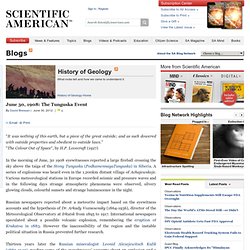
“The Colour Out of Space“, by H.P. Photographic Evidence: The Grossest Things. Remy Melina, Life's Little Mysteries Staff Writer | November 30, 2010 11:49am ET To determine just what is the grossest sight, Valerie Curtis, the director of the Hygiene Center at the London School of Hygiene and Tropical Medicine devised a truly gruesome experiment.
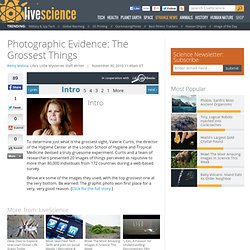
Curtis and a team of researchers presented 20 images of things perceived as repulsive to more than 80,000 individuals from 172 countries during a web-based survey. Below are some of the images they used, with the top grossest one at the very bottom. Be warned: The graphic photo won first place for a very, very good reason. [Click for the full story ] Tanganyika laughter epidemic. The Tanganyika laughter epidemic of 1962 was an outbreak of mass hysteria – or mass psychogenic illness (MPI) – rumored to have occurred in or near the village of Kashasha on the western coast of Lake Victoria in the modern nation of Tanzania (formerly Tanganyika) near the border of Kenya.[1] The laughter epidemic began on January 30, 1962, at a mission-run boarding school for girls in Kashasha.
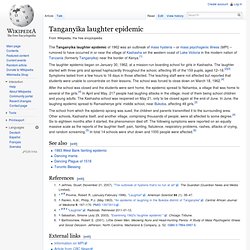
The laughter started with three girls and spread haphazardly throughout the school, affecting 95 of the 159 pupils, aged 12–18.[2][3] Symptoms lasted from a few hours to 16 days in those affected. The teaching staff were not affected but reported that students were unable to concentrate on their lessons. The school was forced to close down on March 18, 1962.[4] Sailing stones. Charles Bonnet syndrome. Charles Bonnet syndrome (CBS) is the experience of complex visual hallucinations in patients with visual loss.

First described by Charles Bonnet in 1760,[1][2] it was first introduced into English-speaking psychiatry in 1982.[3] Characteristics[edit] Voynich manuscript. The Voynich manuscript is an illustrated codex hand-written in an unknown writing system.
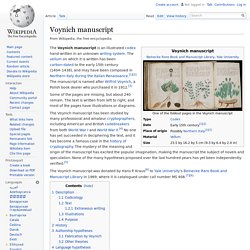
The vellum on which it is written has been carbon-dated to the early 15th century (1404–1438), and may have been composed in Northern Italy during the Italian Renaissance.[1][2] The manuscript is named after Wilfrid Voynich, a Polish book dealer who purchased it in 1912.[3] Methicillin-resistant Staphylococcus aureus. Methicillin-resistant Staphylococcus aureus (MRSA) is a bacterium responsible for several difficult-to-treat infections in humans.
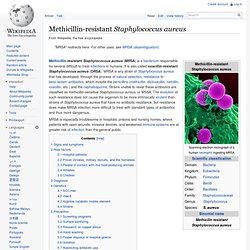
It is also called oxacillin-resistant Staphylococcus aureus (ORSA). MRSA is any strain of Staphylococcus aureus that has developed, through the process of natural selection, resistance to beta-lactam antibiotics, which include the penicillins (methicillin, dicloxacillin, nafcillin, oxacillin, etc.) and the cephalosporins. Strains unable to resist these antibiotics are classified as methicillin-sensitive Staphylococcus aureus, or MSSA.
The evolution of such resistance does not cause the organism to be more intrinsically virulent than strains of Staphylococcus aureus that have no antibiotic resistance, but resistance does make MRSA infection more difficult to treat with standard types of antibiotics and thus more dangerous. Signs and symptoms[edit] Alien hand syndrome. Alien hand syndrome (AHS), is a rare neurological disorder that causes hand movement without the person being aware of what is happening or having control over the action.
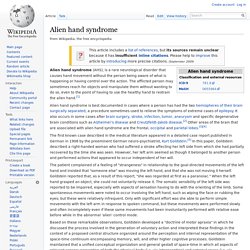
The afflicted person may sometimes reach for objects and manipulate them without wanting to do so, even to the point of having to use the healthy hand to restrain the alien hand.[1] Alien hand syndrome is best documented in cases where a person has had the two hemispheres of their brain surgically separated, a procedure sometimes used to relieve the symptoms of extreme cases of epilepsy. It also occurs in some cases after brain surgery, stroke, infection, tumor, aneurysm and specific degenerative brain conditions such as Alzheimer's disease and Creutzfeldt–Jakob disease.[2] Other areas of the brain that are associated with alien hand syndrome are the frontal, occipital and parietal lobes.[3][4] Anarchic hand syndrome and alien hand syndrome are two similar but separate disorders. Symptoms[edit] Subtypes[edit] Phaistos Disc. The Phaistos Disc (also spelled Phaistos Disk, Phaestos Disc) is a disk of fired clay from the Minoan palace of Phaistos on the Greek island of Crete, possibly dating to the middle or late Minoan Bronze Age (2nd millennium BC).

It is about 15 cm (5.9 in) in diameter and covered on both sides with a spiral of stamped symbols. Its purpose and meaning, and even its original geographical place of manufacture, remain disputed, making it one of the most famous mysteries of archaeology. Raymond Robinson (Green Man) Raymond "Ray" Robinson (October 29, 1910 – June 11, 1985) was a severely disfigured man whose years of nighttime walks made him into a figure of urban legend in western Pennsylvania.

Robinson was so badly injured in a childhood electrical accident that he could not go out in public without fear of creating a panic, so he went for long walks at night. Local residents, who would drive along his road in hopes of meeting him, called him The Green Man or Charlie No-Face. Mystery Missiles & Weather Balloons, UFO’s & Aliens. It doesn't take much to convince people that they've seen an experimental missile or a UFO.

A funny-looking cloud or an exceptionally bright planet will usually do the trick. Mystery UFO halo in clouds over Moscow? Oct 7 2009. Medical Mystery: How Can Some People Hear Their Own Eyeballs Move? Spiders in Pakistan encase whole trees in webs. Seeing in the Dark. Credit: cliff1066tm. Patient TN was, by his own account, completely blind. Two consecutive strokes had destroyed the visual cortex of his brain, and consequently, his ability to see. It is not uncommon for stroke patients to suffer brain damage, but the case of TN — referenced by his initials, the general practice in such studies — was peculiar. His first stroke had injured only one hemisphere of his visual cortex. About five weeks later, a second stroke damaged the other hemisphere. Behind the Secret of the Naga's Fire.
Mistaken Identity. In 1903, a prisoner named Will West arrived at Leavenworth. The record clerk took the photographs above and, thinking he remembered West, asked whether he had been there before. 2011 November 8 - Jumping Sundogs Over Thunderclouds. "Crown Flash" and Leaping Sundogs Meteorological Phenomenon: parhelia altered by thunderstorm e-fields. Crop Circle Images Throughout the World. Freaky Fractal Fingers, Fingers, Fingers.
History's Most Overlooked Mysteries. Tuan C. Nguyen | July 25, 2007 10:23am ET. Irishman Dies of Spontaneous Human Combustion. Piers Gibbon Explains How Amazonian Tribes Make Shrunken Heads. How to Shrink a Human Head. Mysterious Symbols in China Desert Are Spy Satellite Targets, Expert Says. Newfound Google Maps images have revealed an array of mysterious structures and patterns etched into the surface of China's Gobi Desert. The media — from mainstream to fringe — has wildly speculated that they might be Chinese weapons-testing sites, satellite calibration targets, street maps of Washington, D.C., and New York City, or even messages to (or from) aliens.
It turns out that they are almost definitely used to calibrate China's spy satellites. So says Jonathon Hill, a research technician and mission planner at the Mars Space Flight Facility at Arizona State University, which operates many of the cameras used during NASA's Mars missions. Hill works with images of the Martian surface taken by rovers and satellites, as well as data from Earth-orbiting NASA instruments.